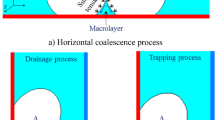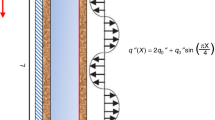Abstract
To meet the extreme cooling requirements in many high-tech fields, it is essential and meaningful to reveal the dominant factors of heat transfer performance of gas–liquid two-phase flow in micro-channel. In the present work, the flow and heat transfer characteristics of bubbly, slug and annular flow in circular micro-channel are numerically studied with the VOF model. Moreover, the field synergy principle is introduced to reveal the dominant mechanisms of heat transfer improvement under various flow patterns. As a result, the evolutions of local Nusselt number, volume fraction and near-wall average field synergy angle along the flow direction under various flow patterns are obtained. Moreover, the effects of gas and liquid flow rates are discussed on the average Nusselt numbers and average field synergy angle. The numerical results indicate that the heat transfer performance of gas–liquid two-phase flow is better than single-phase flow, and the slug flow owns the best heat transfer performance. It should be noted that the heat transfer enhancement of bubbly and slug flow is attributed to the decrease in field synergy angle in the boundary layer. By contrast, the liquid phase velocity near the wall plays a dominant role in heat transfer enhancement of annular flow. Furthermore, the heat transfer performance of gas–liquid two-phase flow is strongly influenced by the gas flow rate, and Reg= 24.5 is the optimal value to enhance heat transfer performance for the condition of Rel= 445. The results are expected to provide theoretical guidance for the design and optimization of the micro-channel heat exchangers.
















Similar content being viewed by others
Abbreviations
- A :
-
Cross-sectional area of micro-channel, m2
- Bo :
-
Bond number \(\left( {(\rho_{\text{l}} - \rho_{\text{g}} )aD^{2} /\sigma } \right)\)
- c p :
-
Heat capacity, J kg−1 K−1
- d :
-
Channel diameter, mm
- d 0 :
-
The inner core diameter of the pipe, mm
- e :
-
Internal energy, J kg−1
- \(\overrightarrow {F}_{\text{S}}\) :
-
Surface tension term, N
- H :
-
Enthalpy, J kg−1
- L :
-
Channel length, mm
- Nu x :
-
Local Nusselt number
- Nu m :
-
Average Nusselt number on the heated section
- P :
-
Pressure, Pa
- Q g :
-
Gas volumetric flow rate, m3 s−1
- Q l :
-
Liquid volumetric flow rate, m3 s−1
- q w :
-
Wall heat flux, W m−2
- Re g :
-
Gas superficial Reynolds number
- Re l :
-
Liquid superficial Reynolds number
- R :
-
Channel radius, mm
- r :
-
Radial coordinate, mm
- T :
-
Temperature, K
- T av :
-
Average temperature of fluid on the heated section, K
- T b :
-
Bulk temperature, K
- \(\nabla \mathop T\limits^{ \to }\) :
-
Temperature gradient vector, K m−1
- T w :
-
Wall temperature, K
- t :
-
Time, s
- \(\overrightarrow {U}\) :
-
Velocity vector
- j g :
-
Gas superficial velocity, m s−1
- j l :
-
Liquid superficial velocity, m s−1
- u :
-
Radial velocity, m s−1
- V i :
-
Volume per control volume
- x :
-
Axial coordinate, mm
- \(\alpha_{\text{g}}\) :
-
Gas volume fraction
- \(\alpha_{\text{l}}\) :
-
Liquid volume fraction (1 − αg)
- \(\rho_{\text{g}}\) :
-
Gas density, kg m−3
- \(\rho_{\text{l}}\) :
-
Liquid density, kg m−3
- \(\mu_{\text{g}}\) :
-
Gas dynamic viscosity, Pa s
- \(\mu_{\text{l}}\) :
-
Liquid dynamic viscosity, Pa s
- \(\lambda_{\text{l}}\) :
-
Liquid’s thermal conductivity, W m−1 K−1
- \(\theta_{\text{i}}\) :
-
Local field synergy angle, deg
- \(\theta_{\text{av}}\) :
-
Average field synergy angle, deg
- av:
-
Average value
- b:
-
Bulk mean
- i:
-
Per control volume
- g:
-
Gas
- l:
-
Liquid
- w:
-
Wall
References
Deng D, Chen L, Wan W, Fu T, Huang X. Flow boiling performance in pin fin- interconnected reentrant microchannels heat sink in different operational conditions. Appl Therm Eng. 2019;150:1260–72.
Xia GD, Tang YX, Zong LX, Ma DD, Jia YT, Rong RZ. Experimental investigation of flow boiling characteristics in microchannels with the sinusoidal wavy sidewall. Int Commun Heat Mass Transf. 2019;101:89–102.
Chai L, Wang L. Thermal-hydraulic performance of interrupted microchannel heat sinks with different rib geometries in transverse microchambers. Int J Therm Sci. 2018;127:201–12.
Abdollahi A, Norris S, Sharma RN. Fluid flow and heat transfer of gas-liquid two-phase flow in microchannels. In: 21st Australasian fluid mechanics conference, Adelaide, Australia, 10–13 December 2018; 12018.
Ribatski G. A critical overview on the recent literature concerning flow boiling and two-phase flows inside micro-scale channels. Exp Heat Transf. 2013;26:198–246.
Saisorn S, Srithumkhant P, Wongpromma P, Suchatawat M, Wongwises S. Flow pattern, heat transfer and pressure drop behaviors of micro-channel flow boiling. In: ASME 2018 16th international conference on nanochannels, microchannels, and minichannels. American Society of Mechanical Engineers; 2018. pp. V001T002A009–V001T002A009.
Chao C, Xu X, Kwelle SO, Fan X. Significance of gas-liquid interfaces for two-phase flows in micro-channels. Chem Eng Sci. 2018;192:114–25.
Smith K, Kempers R, Robinson AJ. Confinement and vapour production rate influences in closed two-phase reflux thermosyphons Part A: flow regimes. Int J Heat Mass Transf. 2018;119:907–21.
Chang H, Fu Q, Zhong N, Yang X, Quan X, Li S, Fu J, Xiao C. Microalgal lipids production and nutrients recovery from landfill leachate using membrane photobioreactor. Biores Technol. 2019;277:18–26.
Abiev R, Svetlov S, Haase S. Hydrodynamics and mass transfer of gas–liquid and liquid–liquid Taylor flow in microchannels. Chem Eng Technol. 2017;40:1985–98.
Vivekanand SVB, Raju VRK. Effect of wall contact angle and carrier phase velocity on the flow physics of gas–liquid Taylor flows inside microchannels. Chem Pap. 2019;73:1173–88.
Kumari S, Kumar N, Gupta R. Flow and heat transfer in slug flow in microchannels: effect of bubble volume. Int J Heat Mass Transf. 2019;129:812–26.
Chen WL, Twu MC, Pan C. Gas–liquid two-phase flow in micro-channels. Int J Multiph Flow. 2002;28:1235–47.
Saisorn S, Wongwises S. Adiabatic two-phase gas-liquid flow behaviors during upward flow in a vertical circular micro-channel. Exp Thermal Fluid Sci. 2015;69:158–68.
Li H-W, Pei H-F, Yang D, Sun B, Zhou Y-L. Analysis of the dynamic characteristics of air-water two-phase flow in small channel based on multi-scale normalized Benford probability distribution. Chem Eng Sci. 2018;179:161–71.
Walsh E, Muzychka Y, Walsh P, Egan V, Punch J. Pressure drop in two-phase slug/bubble flows in mini scale capillaries. Int J Multiph Flow. 2009;35:879–84.
Hetsroni G, Mosyak A, Pogrebnyak E, Segal Z. Heat transfer of gas-liquid mixture in micro-channel heat sink. Int J Heat Mass Transf. 2009;52:3963–71.
Choo K, Trainer D, Kim SJ, ASME. The effect of channel diameter on heat transfer characteristics of two-phase flow in microchannels; 2011).
Osher S, Fedkiw RP. Level set methods: an overview and some recent results. J Comput Phys. 2001;169:463–502.
Li Y, Su T, Liang H, Xu J-R. Phase field lattice Boltzmann model for two-phase flow coupled with additional interfacial force. Acta Physica Sinica. 2018;67:22.
Chiu P-H, Lin Y-T. A conservative phase field method for solving incompressible two-phase flows. J Comput Phys. 2011;230:185–204.
Gupta R, Fletcher DF, Haynes BS. CFD modelling of flow and heat transfer in the Taylor flow regime. Chem Eng Sci. 2010;65:2094–107.
Qian D, Lawal A. Numerical study on gas and liquid slugs for Taylor flow in a T-junction microchannel. Chem Eng Sci. 2006;61:7609–25.
Muzychka YS. Laminar heat transfer for gas-liquid segmented flows in circular and non-circular ducts with constant wall temperature. In: ASME 2014 12th international conference on nanochannels, microchannels, and minichannels collocated with the ASME 2014 4th joint US-European fluids engineering division summer meeting. American Society of Mechanical Engineers Digital Collection. 2014.
Guo ZY, Tao WQ, Shah RK. The field synergy (coordination) principle and its applications in enhancing single phase convective heat transfer. Int J Heat Mass Transf. 2005;48:1797–807.
Chen X, Zhao T, Zhang M-Q, Chen Q. Entropy and Entransy in convective heat transfer optimization: a review and perspective. Int J Heat Mass Transf. 2019;137:1191–220.
Li H, Yu T, Wang D, Xu H. Heat-transfer enhancing mechanisms induced by the coherent structures of wall-bounded turbulence in channel with rib. Int J Heat Mass Transf. 2019;137:446–60.
Tao W-Q, He Y-L, Chen L. A comprehensive review and comparison on heatline concept and field synergy principle. Int J Heat Mass Transf. 2019;135:436–59.
Brackbill JU, Kothe DB, Zemach C. A continuum method for modeling surface tension. J Comput Phys. 1992;100:335–54.
Hirt CW, Nichols BD. Volume of fluid (VOF) method for the dynamics of free boundaries. J Comput Phys. 1981;39:201–25.
Hazel AL, Heil M. The steady propagation of a semi-infinite bubble into a tube of elliptical or rectangular cross-section. J Fluid Mech. 2002;470:91–114.
Triplett KA, Ghiaasiaan S, Abdel-Khalik S, Sadowski D. Gas–liquid two-phase flow in microchannels Part I: two-phase flow patterns. Int J Multiph Flow. 1999;25:377–94.
Rosengarten G, Cooper-White J, Metcalfe G. Experimental and analytical study of the effect of contact angle on liquid convective heat transfer in microchannels. Int J Heat Mass Transf. 2006;49:4161–70.
Acknowledgements
The authors gratefully acknowledge the financial support from the National Natural Science Foundation of China (Nos. 51676208 and 51906257), the Fundamental Research Funds for the Central Universities (Grant Nos. 18CX07012A and 19CX05002A) and the Chinese Postdoctoral Science Foundation (No. 2018M642724).
Author information
Authors and Affiliations
Corresponding author
Additional information
Publisher's Note
Springer Nature remains neutral with regard to jurisdictional claims in published maps and institutional affiliations.
Rights and permissions
About this article
Cite this article
Duan, XY., Li, FB., Ding, B. et al. Heat transfer characteristics and field synergy analysis of gas–liquid two-phase flow in micro-channels. J Therm Anal Calorim 141, 401–412 (2020). https://doi.org/10.1007/s10973-019-08821-5
Received:
Accepted:
Published:
Issue Date:
DOI: https://doi.org/10.1007/s10973-019-08821-5




